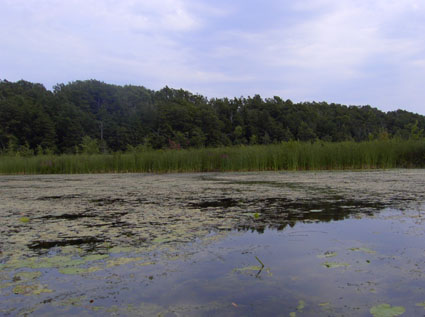
Workshop Series 4:
Watershed-based nutrients
and nearshore ecosystem behaviour

4.2 -
Loading from landscapes and coastal margin effects:
Developing a framework to evaluate consequences
of land management strategies
| March 17-19, 2008 |
| University of Toledo, Lake Erie Center |
| Oregon, Ohio, USA |
*
This page is best viewed using Internet Explorer*
|
SUMMARY Coastal margins of the Great Lakes are experiencing degraded beaches, changes in aquatic community structure, and increased nuisance and harmful algal blooms, ostensibly because of increases in the quantity or reactivity of landscape-derived nutrients. Increasing public concern and demands for action to address these highly visible changes is likely to stimulate the development of land-based demonstration projects to determine how best to mitigate some of these effects. Aquatic habitat characteristics are maintained by dynamic interactions among environmental, hydrological, geological, and biological features. Strategies for long-term habitat protection and restoration depend on our understanding these dynamics as well as characterizing the habitats themselves. The IJC Council of Great Lakes Research Managers is convening this workshop to build a generic framework detailing how one would assess the relative impacts of watershed practices and the effectiveness of land use mitigation strategies on Great Lakes coastal margin characteristics. Guiding Questions:
|
|
Listed below are each of the presentations given
at the workshop. Click on the title to download the presentation The right-hand column contains links to suggested background reading or reference material provided by the author. |
||||
|
|
||||
|
Monday March 17, 2008 |
||||
|
1:00 |
Jan Ciborowski | Overview | ||
|
1:30 |
John Gannon | Findings of IJC nearshore workshops |
Advice to Governments on their Review of the Great Lakes Water Quality Agreement |
|
| 1:45 | Craig Drury |
|
||
| 2:00 |
Peter Richards & Dave Dolan |
Total phosphorus loadings to the Great Lakes | ||
| 2:15 | Lucinda Johnson | |||
| 2:30 | John Morrice | Nonpoint water quality effects on coastal wetlands | ||
| 2:45 | Jack Kelly | Finding signals of landscape in coastal ecosystems | ||
| 3:30 | Sairah Malkin |
The nearshore shunt and phosphorus demand of |
||
| 4:00 | Tom Bridgeman |
Microcystis blooms vs. Maumee River flow 2002-2007 |
||
| 4:15 | Stephanie Guildford |
Microcystin research in Southern Ontario: some recent results |
||
| 4:30 | Bob Heath | Role of labile DOC in phosphate uptake in plankton communities | ||
| 4:45 | Joe DePinto |
Data needs for modeling nearshore systems in the Great Lakes |
||
|
Tuesday, March 18, 2008 |
||||
| 8:45 | Steve Davis | N and P loadings - Augliese R. model | ||
| 11:15 |
Scott Duff Stewart Sweeny |
Agricultural land management practices in Ontario: |
||
| 1:00 |
Nathan Bosch J. David Allen |
An analysis
of catchment nutrient inputs |
||
| 1:15 | Cynthia Sellinger |
Climate-altered hydrology & implications for nonpoint runoff |
||
| 1:30 |
Marguerite Xenopoulos |
Land-water linkages: Land use factors regulating
tributary |
||
| 1:45 | Patricia Chambers |
Nitrogen and Phosphorus standard to prevent
eutrophication of |
||
| 2:00 | Peter Richards |
Trends in dissolved reactive phosphorus (DRP) in Lake Erie tributaries |
||
| 2:15 | Seth Hothem |
Nutrient loads from Northeast Ohio Regional Sewer District
|
||
| 2:30 | Saad Jasim |
The presence of pharmaceuticals, personal care products, and other contaminants in source water |
||
| 2:45 |
George Bullerjahn Mike McKay |
Phosphonates - an unrecognized source of P |
||
| 2:30 | Russell Kreis | |||
|
Wednesday, March 19, 2008 |
||||
| 8:30 |
Moderated by Jeff Reutter |
Great Lakes Research Issues and Recommendations |
||
| 12:00 | Jan Ciborowski | Summary and close of workshop | ||
Website created by Lucie Hannah
Last Updated:
14-May-2008 by Natalie
Carreau
| Back to Top |